Everest Base Camp Trek Itinerary
A lifelong trek experience to the base camp of world’s tallest peak in Nepal!
A lifelong trek experience to the base camp of world’s tallest peak in Nepal!
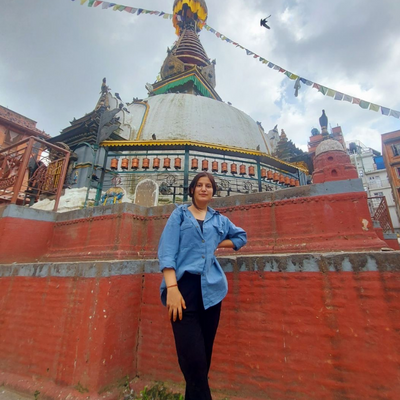
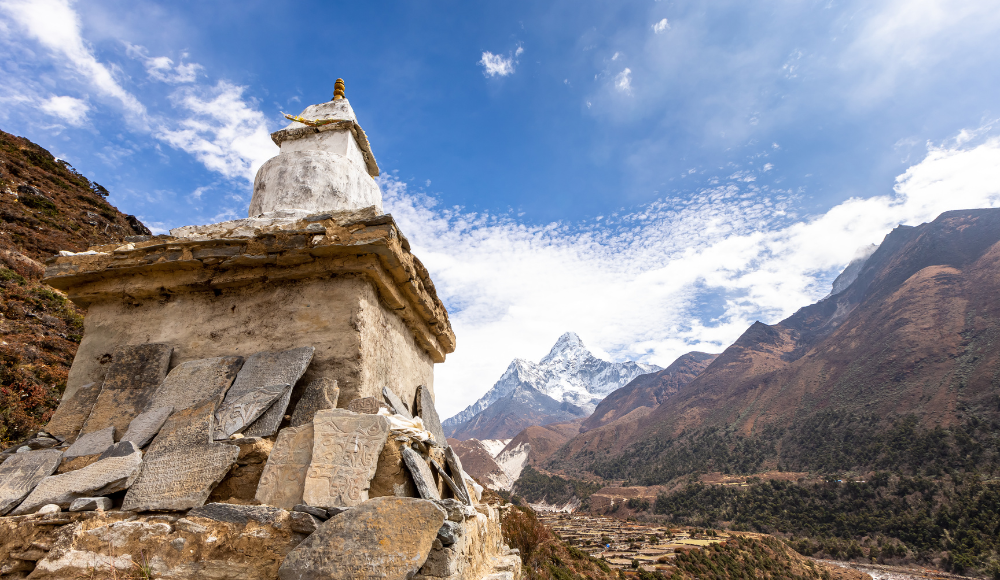
Common queries of many trekkers who are looking to explore Everest, what is the perfect and best possible Everest base camp trek itinerary? Here we are going to unfold the most spectacular, mesmerising, and geographically rich Everest trek itinerary. This 12-day itinerary goes with the involvement of two days as acclimatization which helps to adjust with possible high-altitude sickness in the Everest region. One needs to go through the following details to know complete information about the Everest base camp trek itinerary.
The Everest base camp trek itinerary totals 12 full days starting from your flight from Kathmandu to Lukla. You will be travelling to different places from here which is definitely going to buckle you up for some adventure you have only dreamt of. As you land on the scariest flight to Lukla, You will explore Lukla markets for a bit of time and will check if you have sufficient gear for your trek. This pinpoints the start of your lifelong experience along with an adventurous journey.
After Lukla, you will be hiking up to Phakding, Namche Bazaar, Tengboche, Dingboche, Lobuche, Gorakshep, and finally to the summit, Everest base camp. The trek is thrilling yet satisfying and You will only be pleased with your own accomplishments. There will be no regrets within you and after the trek, you will find one more aspect of your life. This trek is indeed one bucket list thing everyone should add to theirs.
The Everest base camp trek is not like other treks, where you can trek for long distances and observe some spectacular views. This is unique on its own because of the elevation it lies. Not just walking around will take you to the base camp, you need to get accustomed to the new environment of thin air which is the biggest deal here. There may be some obstacles and difficulties you may face during the trek but prepare your mindset of completing this trek and jump into it.
The trek to Everest base camp is not something that can be accomplished easily. You have to manage your schedule(as it can't be accomplished within 2 or 3 days), take a break from your hectic life, get close to nature, and prepare mentally and physically for the trek. We will be sharing our detailed trek itinerary with you and you are advised to follow it for the completion of your trek.
There are several itineraries to reach Everest base camp but here we have designed it in such a way that you will be comfortable enough throughout your trek and will get adapted to the new environment. After going through our detailed itinerary you will definitely gonna try it as it is designed identically and practically concerning the harsh environmental conditions. Below here, you will find all the necessary travel guides, suggestions, and itineraries you will need along the trek so pay your visit to this full article.
|
Trek |
Everest Base Camp Trek |
|
Duration |
12 Days |
|
Base Camp Elevation |
5364m |
|
Highest Altitude |
5645m (Kala Patthar) |
|
Trek Location |
Khumbu Region |
|
National Park |
Sagarmatha National Park |
|
Trek Difficulty |
Moderate to Strenuous |
|
Starting, and Ending Point |
Lukla |
|
Lukla to Base Camp Distance |
52 KM |
|
Peak Season |
|
|
Major Attractions |
|
|
Permits Required
|
|
Get in touch with our experts right away and finalize an experience!
About UsEverest base camp settles in the eastern development region, province no 1, Solukhumbu district which is known as the Khumbu region. It is a popular trekking site lying just in the lap of majestic Everest preserving the diverse flora and fauna of that region. Standing on an elevation of 5364m, the Everest base camp holds its own significance over all the attractions scattered over Sagarmatha national park.
Being the heartthrob of the Everest region, the Everest base camp surrounds itself with amazing natural gifts and wonders. It can be reached from Lukla which follows the trails of Lukla, Phakding, Namche Bazaar, Tengboche, Dingboche, Lobuche, Gorakshep, and Everest base camp. After your trek to base camp, you can come back to Gorak Shep and hike to Kalapathar for the glorious(during sunrise) and magenta view(during sunset) of the high Himalayans.
Sounds astonishing but there is an interesting fact about Everest base camp, that is, you can observe various attractions such as thick dense pine forests, parasitic lichens, colourful Rhododendron forest, amazing glaciers, deep blue lakes, stunning landscapes and gorges, high-velocity rivers and lifestyles of Shera people. But you cannot observe Mount Everest from this region. This identifies Everest base camp as a unique mischievous destination to trek.
With its fascinating trails along with the attraction immersing in it, Everest base camp enchants the trekkers and allures them. Trekkers define the trek to base camp as mystical enchantment with mesmerizing forests and rivers. Every year thousands of trekkers trek to the base camp and enjoy its aura and suggest everyone to visit it once in their lifetime.
Related Article: Where is Mount Everest located?
There are two possible options to reach the Everest base camp trek:
Flight from Kathmandu to Lukla
Flight from Ramechhap to Lukla
Flight from Kathmandu to Phaplu
Helicopter from Kathmandu to Lukla or within the Everest region
You have two choices here, flight or heli ride. You can choose among these two on your own preferences. One of the much appreciated and accompanied is the flight to Lukla which takes about 45min. Due to the heavy traffic congestion during peak time, there has been a diversion which is a flight to Ramechhap, and from there you can to and fro to Lukla and Kathmandu. The flight to Lukla is considered the scariest and most dangerous flight and you may suffer a fair few nerve-wracking bumps before the landing.
Another one is a heli ride. It is considered a luxurious ride that takes you directly from Kathmandu to Lukla and after checking of fuel and engines is done, it will redirect you to Everest base camp and you don't need to trek for several days. You will get to observe all the beauties and scenery through aerial view and get lost in it. Once your visit to Everest base camp is done, you will be taken back to Lukla as the weather around here is very fluctuating and you don't want to be stuck in the chill inclement environment of Everest.
Alternative to air, you can go with the drive. The most followed trail in current days is the drive to Salleri and a 4 to 5 days trek from there. This is the trail that has been discovered recently but this is not the only trail to reach Everest base camp. There are several trails among which drive to Jiri and 10 days of a trek from there is the traditional one. A few trekkers prefer this too so it's completely on your own preference on which trail to follow. The folks who love long rides can go for the drive option, getting themselves immersed in the hypothetical scenario during the drive.
|
Day 01 |
Fly from Kathmandu to Lukla, Trek to Phakding |
|
Day 02 |
Phakding to Namche bazaar |
|
Day 03 |
Namche Bazaar acclimatization |
|
Day 04 |
Namche Bazaar to Debuche |
|
Day 05 |
Debuche to Dingboche |
|
Day 06 |
Rest day in Dingboche |
|
Day 07 |
Dingboche to Lobuche |
|
Day 08 |
Lobuche to Gorak Shep, Trek to Everest Base Camp, back to Gorak Shep |
|
Day 09 |
Kalapathar sunrise hike, Trek to Pangboche |
|
Day 10 |
Pangboche to Namche Bazaar |
|
Day 11 |
Namche Bazaar to Lukla |
|
Day 12 |
Lukla to Kathmandu |
|
Day |
1 |
|
From |
Lukla |
|
To |
Phakding |
|
Duration |
5-6 Hours |
|
Distance |
9 KM |
|
Elevation |
2610m |
Adventurous flight from Kathmandu to Lukla.
Lukla village exploration.
Rivers and suspension bridges.
This is the first day of the trek, iconically the beginning of Excitement, starting with the flight to Lukla. Lukla flight is one of the most dangerous flights yet exciting and thrilling. The landing of the flight is quite scary as the plane is inclined at 15 degrees directly from the air and because of that, it will be bounced on the land providing goosebumps all around. After your arrival at Lukla, you will explore Lukla markets, do the final check of all the necessary gear you will need during the trek, and prepare for the trek.
Here, First of all, you have to take both permits, Sagarmatha national park permit, and Pasang Lhamu rural municipality entrance permit. In case you have forgotten to take a national park permit from DNPWC Kathmandu, you can purchase those from here. You can purchase a National park permit from other places too but for the Pasang Lhamu permit, Lukla is the only option you have got. Be sure of the permits before starting the trek.
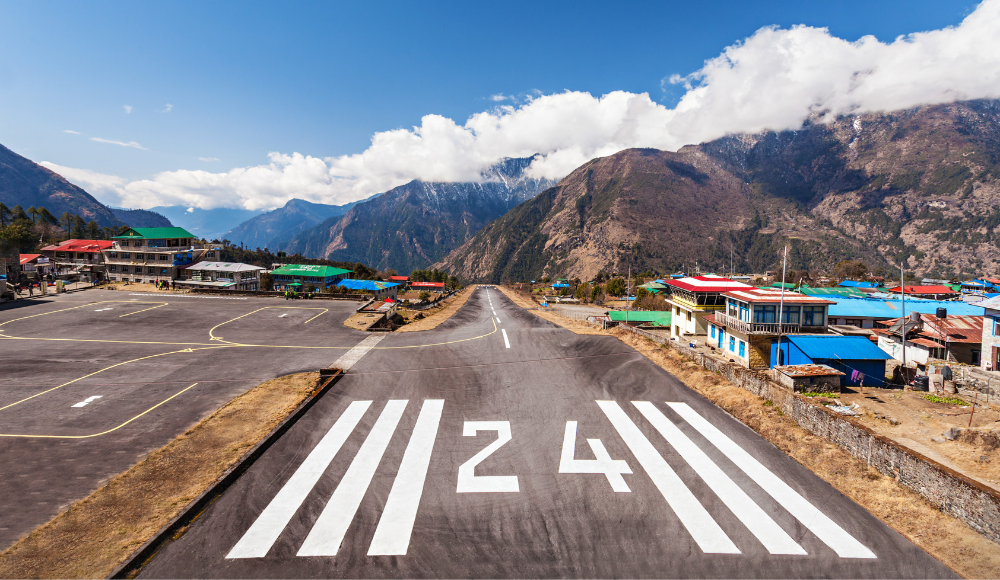
The entire trek will be a descend from Lukla (2860m) to Phakding (2610m). So, the trail to Phakding is quite easy and beautiful and you will not feel any hardships during this trek. You will compare this hike with the previous hike you have done and will feel nothing special for the first few minutes. But once you encounter those suspension bridges, the real excitement starts to flood in and you will be aroused by it. Here, you will cross a few suspension bridges. Also, you will notice the Dudh Koshi river flowing at the greatest speed with the large soaring in the background. And this noise can be heard along with the chirpings of birds during your entire trek to Phakding.
After trekking for about 5 to 6 hours, approximately 9KM through the busty forests alongside the dusty trails you will reach a beautiful Sherpa village lying at the elevation of 2610m, this is Phakding. Here the basic amenities are all available. You can have access to the internet, good food, nice tea houses for accommodation, electricity, Atm services, pharmacies, a hot shower, and multiple gear shops.
After reaching Phakding you will rest in a teahouse and have warm meals and prepare for your next day (this is all for day 1). In Phakding, attached bathrooms are there in your room suite so no need to pay extra for it. Here the electricity facility is all free so make sure to charge all your electrical gadgets here.
There is no motor road for the shipment of goods(furniture, clothes, foods, and many more raw materials), so for this purpose, there is the provision of porters and load-carrying animals. Donkeys and Yaks (Himalayan Cow) are two animals that carry the loads up to the higher altitude. Donkeys can reach a certain altitude but for more elevation yaks are used.
There are these conventions over here, that is, if you have to use porters or animals, then you should pack your essentials before 7am next morning and after that, the porters or the animals loaded with your goods will depart from there to your next stay. Then you can slowly follow them to the next estimated destination. Because of these animals' back-and-forth walking, the trail is quite muddy and dusty. So, You will have to carry masks here.
|
Day |
2 |
|
From |
Phakding |
|
To |
Namche Bazaar |
|
Duration |
6-7 Hours |
|
Distance |
11 KM |
|
Elevation |
3440m |
Trek on the shores of Dudh Koshi river.
Dense pine forests.
Suspension bridge that is on the confluence point of two rivers, Dudhkoshi and Imja.
Namche Bazaar.
It is the second day of your itinerary. You will start by waking up at 7 am, packing your goods, giving them to porters, and heading for breakfast. Since a long journey is ahead of you will have some healthy and energizing breakfast and start your next day's trek. Be sure to carry enough water and don't ever use tap water as it may lead to serious health problems.
Now you are one step closer to base camp so it is common that you will receive a new rush of adrenaline. Compared to the previous hike, today's hike is going to be more arduous as you have to go the steep uphill from Phakding (2610m) to Namche Bazaar(3440m). This will definitely pull your leg real hard for sure cause gaining a net elevation of 830m in one day is not a piece of cake.
During this trek, you will encounter the first visitor centre at Monjo (2845m) where you will have your national park permit checked. If you have not received your national park permit yet, you can get that from here also. Then you will be heading ahead to reach Namche Bazaar, which is called the gateways of high Himalayans.
After Monjo, you will be trekking by the shores of the beautiful Dudh Koshi river. The muddy steep uphill will definitely buzz you about the difficulty you are gonna face to reach the summit. Trekking beside the shores itself is the most satisfying thing. Alongside this, the beautiful dense pine forests make it extra special and fabulous.
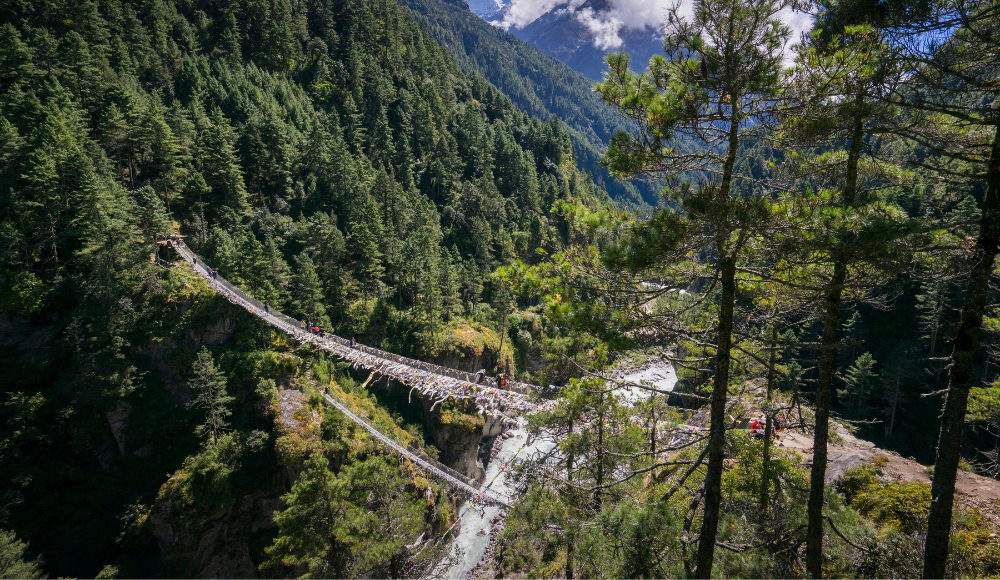
After going through the pine forests, you will pass through many suspension bridges. Some of them are just fun while certain ones are frightening. Tenzing Hillary suspension bridge is the one renowned suspension bridge in this region, which is named in the honour of late Edmund Hillary. This is on the confluence point of the Dudh Koshi and Imja rivers which makes it really incredible. This is the last suspension bridge before reaching Namche bazaar. Those who have acrophobia(fear of heights) are advised not to look down.
Just before reaching Namche Bazaar, there is a checkpoint called Jorsalle checkpoint, where your permits are checked and then only you are allowed to enter the national park region. After this checkpoint, there is a huge gate saying “Welcome to Sagarmatha national park”, now you have successfully reached Namche Bazaar as the gate is the entry point to Namche Bazaar.
From Namche Bazaar, you will get to see the first view of Everest if you get there before sunset. As the trek is quite hard, you will go to your booked hotel, enjoy your meals, and rest. This is it for your second day. For the following day, you already have your schedule prepared in the itinerary.
|
Day |
3 |
|
From |
Namche Bazaar |
|
To |
Everest view hotel |
|
Duration |
6 hours |
|
Distance |
8 KM |
|
Elevation |
3880m |
Sherpa culture museum.
Sagarmatha national park visitor centre.
Tenzing Norgay Memorial Chorten.
Namche Monastery.
Thame, Khumjung and Khunde village.
Everest view hotel.
Starting your day with warm coffee, today is the day of acclimatization and you will not hike above, and adapt to this altitude. Remember this, acclimatizing is the most important thing for completing your trek to base camp. You will explore Namche Bazaar today, known as the gateway to the high Himalayas and a famous trading center in this region.
From Namche Bazaar you can observe the first glance of Mount Everest. Here, all the facilities like banks, ATMs, gear shops, bakeries, hotels, lodges, electricity, and pharmacies are available. You can buy any gear in case you have forgotten it before. There is this large market here, where you can buy anything you want, the only difference is in the cost, it's a little expensive here as the transportation facility is the biggest problem.
There are many attractions in Namche Bazaar and it is quite popular among a large group of people. One of which is the Sherpa culture museum. In the sherpa culture museum, you will get to observe traditional artefacts of the Sherpa ethnic community. The museum is built in traditional Sherpa architecture with the appearance of a traditional Sherpa house. The museum has a living room on the first floor and a praying room beside it, and below these, there is a cow stable and a hay store just like it used to be in the traditional Sherpa house.
Not just the sherpa museum there are other features too, which pull the visitors into it.
Sagarmatha National Park visitor center is one of the most visited sites in Namche Bazaar. Here you can get all the necessary information about this national park including the details of the mountains, climbing information, floras, and faunas in this region, permit information, and many more.
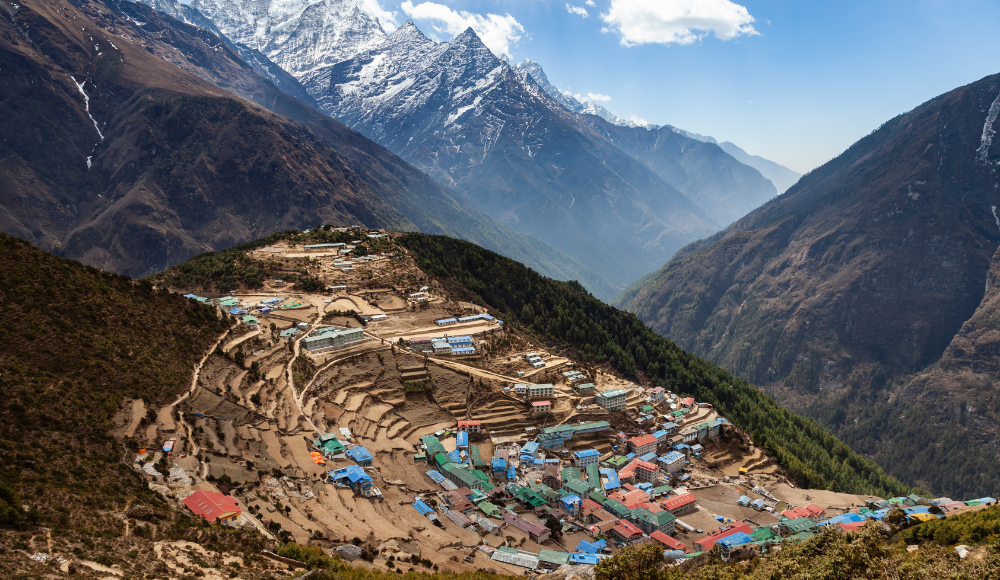
As Tenzing Norgay is renowned worldwide as the first person to find victory over great Everest, a Chorten has been built at the edge of Namche Bazaar honoring him. From here you can observe spectacular views of mount Lhotse, Nuptse, and Everest. It can simply be considered an amazing viewpoint too as the sight you will spot from here is phenomenal. Also, there is this hotel called Everest view hotel(3880m), where you can have meals and enjoy the scenery of the Mountain range. In the previous days, this hotel was given the title of a hotel lying at the highest altitude but for now, it is replaced by others.
As Namche is the zone of Sherpa inhabitants, it would be incomplete if there is no monastery. Meaning you can find monasteries at the place. One famous monastery in this region is Namche Monastery. Usually, during the festival time, many people gather around here, perform prayer, sing, dance, and enjoy. You can give it a visit during your stay at Namche and gather information about Sherpa culture and tradition.
Also, you can visit small Sherpa villages such as Thame, Khunde, and Khumjung and observe the traditional Sherpa lifestyles, their habitation, vegetation, and farming. These villages are small yet full of the original Sherpa culture as there is no influence from the western region.
Not just for the attractions, it is quite popular as a business trading centre. Tibetan Buddhists markets are here in abundance with various goods and supplies. Every Saturday morning, a huge market is organized here, locally called a Hatbazaar, where all of the goods they possess are displayed openly and they provide particular sales too. Additional to these, homemade yak cheese and butter are also available here.
These are all the places you can pay a visit during your acclimatization day in Namche. At last, you can enjoy Nepali delicacies(dal bhat) and get rest and prepare for the next day's trek. Also, remember that a positive attitude is the most for completing any task, so surround yourself with positivity and keep moving. This is it for your third day of the trek.
|
Day |
4 |
|
From |
Namche Bazaar |
|
To |
Debuche |
|
Duration |
6-8 Hours |
|
Distance |
10KM |
|
Elevation |
3745m |
Juniper, birch forests.
Tengboche monastery.
Imja valley.
A new day added to your calendar that will drag you one step closer to the base camp. You will start the trek by having some breakfast in Namche. After this, you will be going steeply uphill along the dusty trails. After a bit of hiking, you will pass through a small mountain school where the children are playing, chattering, and enjoying themselves all around and you will reminisce about your early childhood days.
Hike with all the energy you muster, but slowly as “slowly and steadily wins the race”. Moving upward you will be hiking beside the Juniper forests. Juniper berries are used in the west region to make a gin(alcohol) but here in this region, it is treated as a sacred plant. You will observe that in every monastery and lodge, there is a chimney outside of it, and every morning they used to burn these juniper leaves and surround the environment with its aroma. It is supposed to attract good luck.
During your hike, you will observe some Mani stones on the way crafted by the Monks. It is believed that it is a sort of prayer performed by the monks as they sit there, and carve in it for several days chanting the mantras. It holds religious beliefs so don't perform any activity violating these beliefs. Also, there are multiple praying wheels(Mani) on the way back there, and there is a practice where you have to go through its left side(your right side) rolling it in a clockwise direction for good fortune.
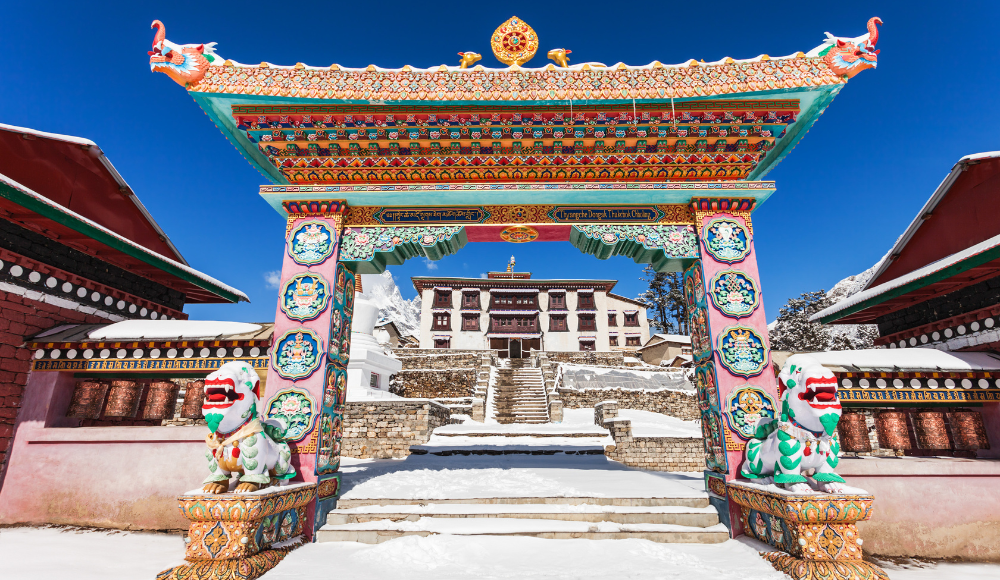
Hiking up furthermore, you will observe this beautiful and remarkable Imja valley. It looks amazing from the altitude you have reached till now. After a little bit of descent, you will stop in Phunki Thanga for lunch and rest. And again you will resume the trek drinking lots of water and climbing uphill. Here, you will walk beside the Birch forests and see a hanging plant in these trees, those are the parasitic lichens. During ancient times the bark of these Birchs was used to make papers.
After hiking more, you will reach the Tengboche monastery. Tengboche monastery is popular as the oldest monastery in this region and popular Sherpa festivals Mani and Dumje Rudu are celebrated grandly in this monastery. Here you will get to observe monks performing everyday prayer rituals which is quite a sight to see.
The trail up to Tengboche monastery is steep uphill, so it is quite hard in comparison to the previous hike of Namche. But after this, there is a descend which will lead you to Debuche which is only 10 to 15 min far from here. Though your legs are incorporating to hike more, by spotting your destination that close, you will pull yourself together and continue to hike. Eventually, you will reach Debuche, have dinner over there and get some rest. This marks the end of your fourth-day trek.
Also, The amenities in Debuche are quite good with no extra charge for hot water and electricity with good food.
|
Day |
5 |
|
From |
Debuche |
|
To |
Dingboche |
|
Duration |
6-8 Hours |
|
Distance |
10 KM |
|
Elevation |
4410m |
View of Ama Dablam, Lhotse, Nuptse.
Birch, conifers, and Rhododendron forests.
Pangboche village.
At the very beginning of the day you will have breakfast in Debuche and head towards Dingboche. For the first few minutes, you have to walk through the same trails you crossed yesterday upto the Tengboche monastery and from there you will hike above the new trail to reach Dingboche. The hike to Dingboche is not that difficult as the trail is nice and easy.
Hiking up above, you will reach the beautiful Pangboche village. It is a small Sherpa village engaged in farming activities. Mainly potatoes and barley are the two main crops harvested around here. After reaching Pangboche, you will hike alongside the Birch, conifer, and Rhododendron forests. Trekkers call this forest an enchanting forest because of its marvellous beauty.
Crossing the charming forests, and hiking, you will reach the amazing destination from where you can observe the glamorous Amadablam, Lhotse, and Nuptse. If you are lucky enough and get there on a clear bright day, you will be mesmerized by the beauty ahead of you. Especially Amadablam looks incredible from here.
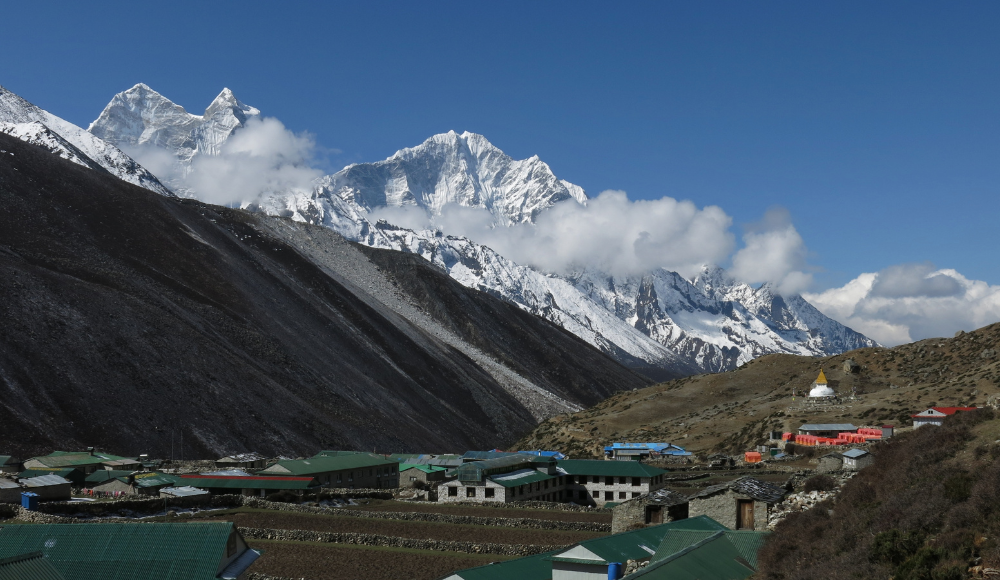
After passing through these trails, you will reach a village called Shomare, where you will have your lunch. Resting for some time, you will resume your hike with the new energy you have gained. The remaining trail to Dingboche is quite easy as you will hike in the flat straight land.
Additional two hour hike is necessary to reach Dingboche. Continuing the hike from Shomare, passing through the woodlands, you will spot a small bridge. This marks your arrival at Dingboche. You will have dinner and rest in your booked teahouse. Also, you have to pay extra charges for hot water and electricity over here. This sums up your fifth day of the trek.
|
Day |
6 |
|
From |
Dingboche |
|
To |
Nangkartshang viewpoint hike |
|
Duration |
4-5 Hours |
|
Distance |
4 KM |
|
Elevation |
5070m |
Dingboche village exploration and rest.
Nangkartshang view point.
Amadablam, Lhotse, Nuptse view.
This is the 6th day of the trek which is estimated for acclimatizing. You can do anything on this day like play poker with friends, drink, enjoy or go for a shorter hike. On this day you will practice acclimatizing and try to get accustomed to the new environment. If you are lucky enough, you will have wonderful weather and will get to enjoy the views, if not, you will be surrounded by flurries of snow all around.
Many of the trekkers simply go for a hike to a viewpoint called Nangkartshang viewpoint. From here you can spot the glamorous mountain range such as Amadablam, Pumori, Lhotse, Nuptse and so on. Alternative to this, a portion choose to stay in their lodge and enjoy the dishes available by playing poker with their friends.

Staying up here in Dingboche refreshes your mood and you will get time to look after your physical fitness too. You can have one amazing drink over here, that is, ginger lemon tea. Usually it is included in the menu of every teahouses, hotels and lodges of Everest region as it is found to prevent cold and sore throat. You can enjoy this drink as it is good for your health and tastes divine too. Summing up, this day is all about enjoying nature considering your physical health.
|
Day |
7 |
|
From |
Dingboche |
|
To |
Lobuche |
|
Duration |
5-6 Hours |
|
Distance |
8 KM |
|
Elevation |
4930m |
Panoramic views of mountains.
Marines and lateral marines of Khumbu glacier.
Memorial.
This day will be the most memorable day of the trek as you will be welcomed by the Panoramic sight of the majestic Himalayans(locals call it the Cathedral of Gods). Almost all of the peaks can be spotted from here such as Amadablam, Cho Oyu, Lhotse, Thamserku, Cholatse, and many more. You will be brimmed with the achievements of peppering all these legendary mountains forgetting all the hardships you have faced during this trek.
The trail to Lobuche is uphill with exceptional marines and lateral marines formed by the Khumbu glacier in ancient times. You have to walk through these marines and in between them too. Walking a little bit more, you will notice a U-shaped valley, this is the valley formed by the Khumbu glacier about 15 to 20 years ago. This view is spectacular.
Following the rocky sandy trail and crossing crystal clear streams, you will reach a village called Dughla. Here you will have your lunch and rest for about 15 to 30 minutes and resume the hike. Heading up ahead, you will reach the Lobuche pass which is considered a somber place.
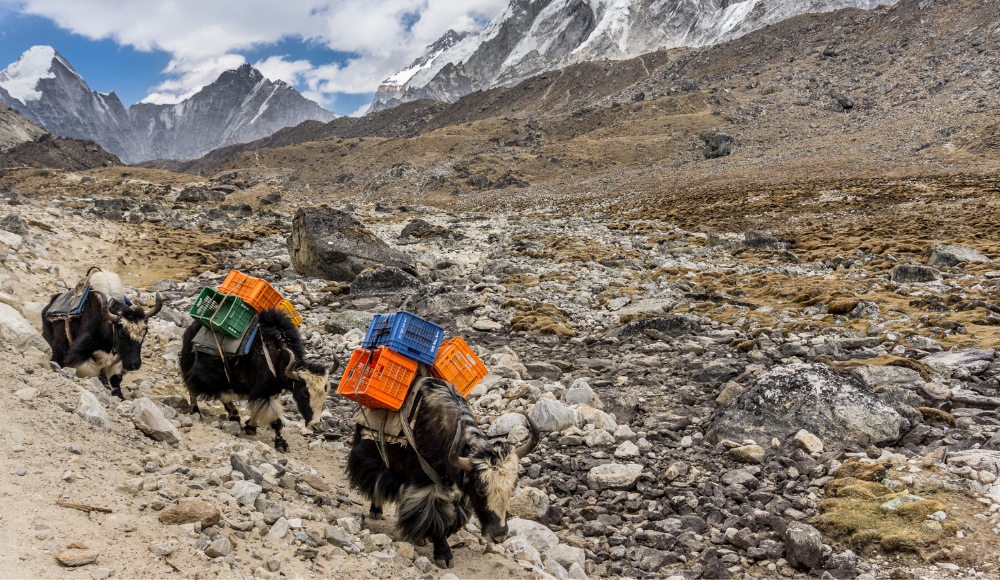
You will feel this strange gush of the air around here. It is a memorial filled with chortens all over the landscapes of the departed souls who rested while climbing Everest. The environment around here makes you quite emotional but subside it as death is all natural and hike above.
Continuing this all, along with the exquisite view, and hiking on the moraines you will reach Lobuche eventually and rest there for this day. Have garlic noodle soup, plenty of water, dal Bhat(rice lentils) and many more Nepali delicacies, vitalize your strength, and prepare for the next day. This is how your 7th day will get covered in the itinerary.
|
Day |
8 |
|
From |
Lobuche |
|
To |
Gorakshep, Everest base camp |
|
Duration |
6-8 Hours |
|
Distance |
12 KM |
|
Elevation |
5175m |
Everest Base Camp Visit.
Gorakshep valley.
Khumbu Glacier.
On this day you have to hike up to Gorak Shep, have lunch over there, resume your hike to base camp, spend a little time there and also return and rest your day at Gorak Shep. Trekking for the past 7 days you may have already estimated how you're gonna cope with this. So, there will be no more problems for you except altitude sickness.
Starting your day with breakfast at Lobuche, you will head ahead packing your gear, and essentials. The trails to Gorakshep are completely rocky and sandy with glaciers all around and beneath. The trail may become slippery if there is snowfall. Here timing matters, as the weather changes rapidly. If you get there in the right weather there may not be any complexity but on the contrary, you may have to stop your trek and wait for the weather to get cleared.
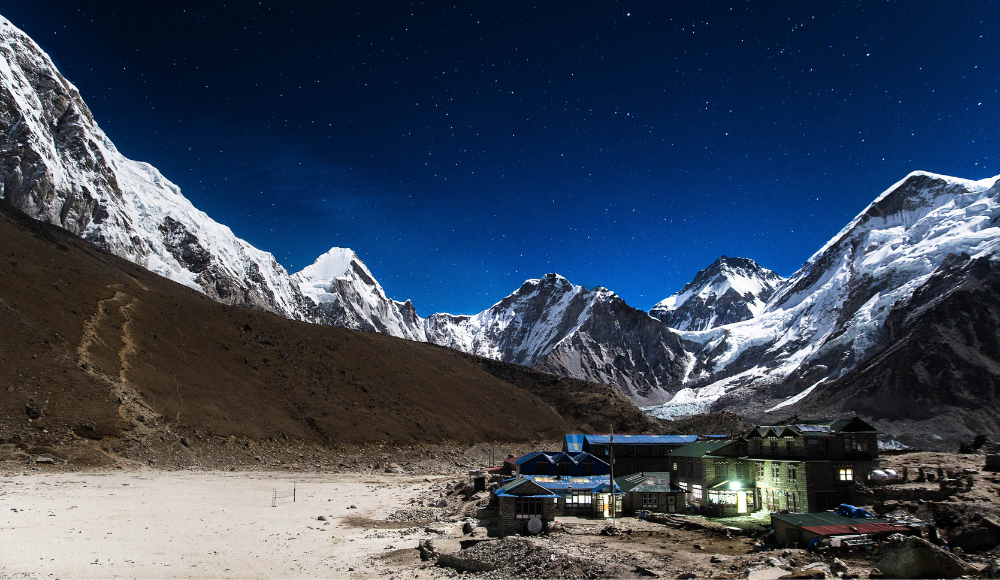
Climbing above you will reach the Gorakshep checkpoint where minor checking is done. Gorakshep is a tiny Sherpa village with just basic amenities. At the lodges and hotels available there, You will have lunch. Generally, the locals serve you ginger lemon tea and garlic noodle soup which is believed to take care of the coldness and mitigate mountain sickness. After resting for particular periods, you can leave your heavy bags at the hotels you will be resting in and continue to the summit.
One fascinating fact about Gorakshep is, it used to be the original Everest base camp. Later, it was shifted to the present base camp which is at an elevation of 5175m.
It is a magnificent day as your dreams come true when you will get to reach the summit, Everest base camp. Mountains such as Amadablam, Lhotse, Thamserku, Nuptse, Lobuche, and Pumori are spotted amidst the trek. You will gain a lifelong experience walking between the ridge of great mountains as Pumori on your right and Lhotse on your left.
This trail is considered the most strenuous overall. It's not because it is steep or hazardous but because of the influence of altitude sickness as it will get more triggered, hence making the hike difficult. You may start to feel symptoms such as heavy breathing, drowsiness, headaches, body aches, joint pain, sore throat, sleepwalking, and extreme shivering of limbs.
With the captivating scenario hugging you all around, walking above the rumbling glaciers, and coldness eating you alive, you will make it up to the base camp eventually. The first view you will get from there is of the Khumbu glacier. It seems phenomenal and just the thought of it thrashing all over will scare the hell out of you.
The immense joy trekkers receive after reaching the base point is visible on their faces. Most of them take photos holding their National flag and dance with amusement. Not only reaching the summit is your achievement, Additionally to these, you will also get to know people from all over the world. Get a chance to communicate with the entire world and exchange culture and tradition.
After this, you will return to Gorak Shep village, have dinner, and rest. This is all for day eight which becomes the most satisfying day on your entire trek as you reach base camp. A new relief paints you after you visit the base camp and with the satisfaction of this victory, you will rest well in Gorak Shep for the night.
|
Day |
9 |
|
From |
Gorak Shep |
|
To |
Pangboche |
|
Duration |
6-8Hours |
|
Distance |
4+18=22KM |
|
Elevation |
3985m |
Mount Everest.
Kala Patthar Sunrise Hike.
Glorious Mountain Views.
Waking up at 3 am indicates the beginning of your ninth-day trek. The very first thing you will do before starting the trek is, have warm tea and then only head ahead. Today you will go to Kalapathar for the sunrise view. Kalapathar trek is one optional trek, you may or may not go but if you are in a fine state of physical fitness don't miss this trek. This trek involves the awe-striking views of Everest along with the other mountain range at the time of sunrise.
Kalapathar is the place from where you can gaze at Everest, unlike EBC. The name Kalapathar is believed to be placed by some random Indians. If you could reach there before sunrise, you will be enthralled by the beauty you encounter. It seems heavenly. The sun just behind the mountains glowing vigorously and spreading light all over the world makes the mountains appear crystal clear white, shining with glamour.
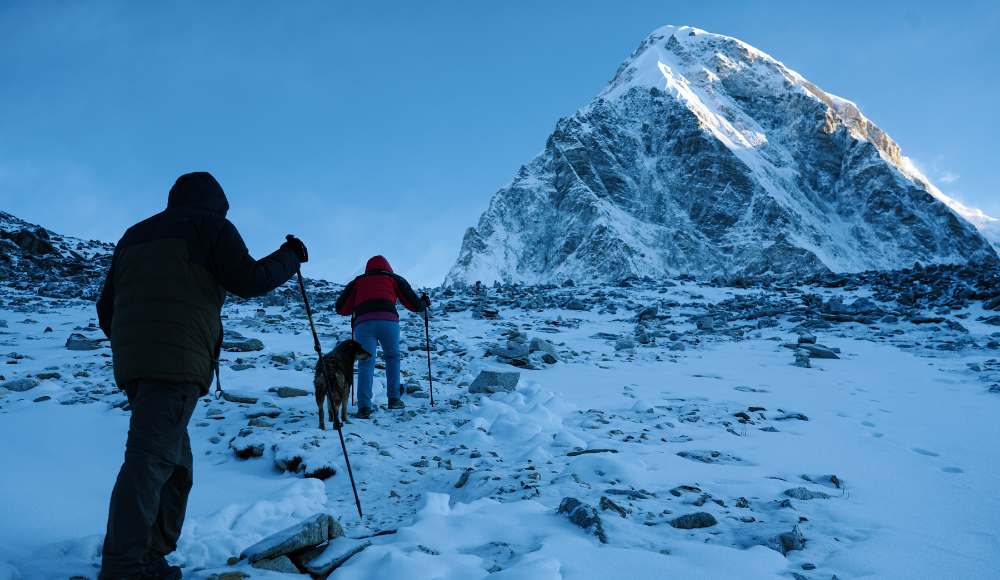
The sight you catch there is unforgettable, you can't get enough of it and greed for more. It feels like the mountains with their aura are enchanting some spell and you are getting lured towards it without realizing it.
After getting back from Kalapathar, you will head back to Gorak Shep, have breakfast, and descend towards the Pangboche. You will be at ease as you are returning from there and even dance with happiness as you can get enough oxygen as you reach the lower region. You will cross Lobuche pass, Lobuche, and walk upon the various Sherpa villages.
After some descend, you will reach Khunjuma. Here you will have your lunch and resume your downward hike. Since it is the descend, you will not face that much difficulty but the trek is entirely monotonous. In some time you will reach Pheriche. After hiking around 5.3km from Pheriche you will reach Pangboche. This is where you will rest for today.
One additional thing is you have to pay about 700 bucks for charging your electrical devices in Gorak Shep but here in Pangboche, there is a decrease. You could do it at around 200 bucks. And also the meals over here are pretty good along with the other amenities.
|
Day |
10 |
|
From |
Pangboche |
|
To |
Namche Bazaar |
|
Duration |
6-8 Hours |
|
Distance |
13KM |
|
Elevation |
3440m |
Tengboche Monastery.
Grasslands.
Pubs in Namche.
Heading downward after breakfast at Pangboche, you will hike to reach Namche Bazaar from where you could feel more civilization. First, you will reach Debuche, then Tengboche, and at last the Namche Bazaar. As you get down you could notice the gradual increase in vegetation.
As you have already covered the trail during your ascend, there is no extra visual you will get during your descends. It's all the same but when you will climb up to the Tengboche from Debuche you will feel as if you are getting into the new domain as the trail changes from woodland to grassland.
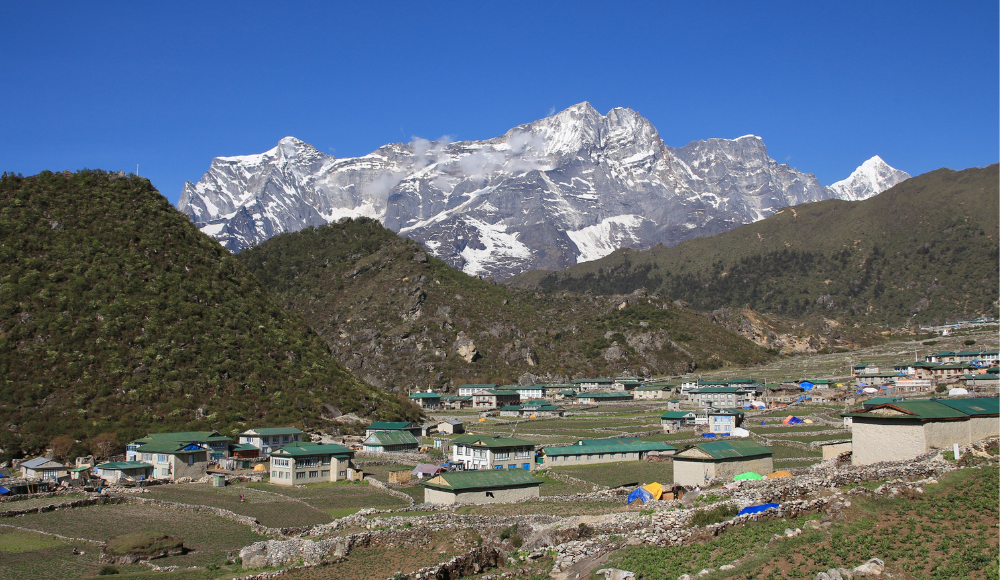
The alpine grassland at Tengboche makes it extra special. The monastery along with the grassland seems fabulous. In this grassland, you can play for some time and enjoy the scenery. Getting down from Tengboche and hiking for some time you will reach Namche Bazaar.
At Namche Bazaar, you can take hot water showers and enjoy good meals. Alongside this there are many pubs around here. You can go and get into its bustle. Also you can drink along with your friends and spend quality time together. At the end of the day you will have dinner and rest. This marks the end of your tenth day on the trek.
|
Day |
11 |
|
From |
Namche Bazaar |
|
To |
Lukla |
|
Duration |
6-8 Hours |
|
Distance |
18 KM |
|
Elevation |
2860m |
Suspension bridges.
Rivers side walk.
Local villages.
Starting the day with the warm tea and breakfast from Namche Bazaar, today you will head to Lukla which theoretically puts the end to your trek to EBC. The trail is easy and you will enjoy the descend because of the vegetation accompanying you all the way down such as lichens, shrubs, and pine forests.
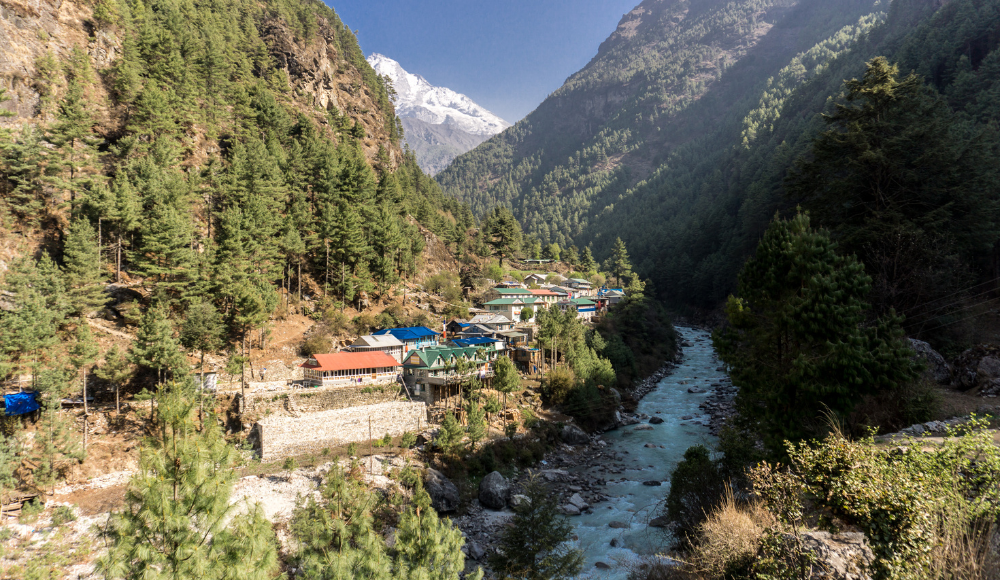
Hiking more you can observe various suspension bridges hanging above the rumbling rivers. If you are acrophobic(scared of heights) you are advised not to look down and just keep moving straight ahead. As you have already practiced this during your ascends you will be comfortable adapting this all.
After the hike of 7 to 8 hours, you will reach Lukla. Once you get to Lukla you will feel more civilization circling you all around. There are plenty of facilities available here. You could go around this place and observe the markets, get something as a souvenir, go to your hotel, have dinner, and rest for the day. This is all for the last day stay at Everest region.
|
Day |
12 |
|
From |
Lukla |
|
To |
Kathmandu |
|
Duration |
45 Minutes |
|
Distance |
By Flight |
|
Elevation |
1350m |
Scenic flight from Lukla to Kathmandu.
Kathmandu's nightlife.
Food in Kathmandu.
This is the last day of your trek to EBC. Getting up early and having breakfast, you will head for the Lukla airport. As the weather over here is unpredictable there is no guarantee of the flight landing and taking off. So you may have to wait for the next day in some cases too if the weather is not clear. If you are lucky enough you will get into the flight the same day you have booked for and get back to Kathmandu.
Lukla airport is taken as the scariest airport and the flight to and from there is also considered the scariest one. The bumping you will experience while you are landing in Lukla is the most frightening and taking off from Lukla will definitely pull a life out of you as it seems like it's gonna hit the landscapes.
Besides the landing and taking off part, everything is perfect as you will get to catch aerial views of the Mountain range, glaciers, lakes, rivers, woodlands, and many more insights of the Everest region. The views from high above the clouds look just ethereal. Mountains sparkling with its radiation, dense green forests bordering the territory and the rivers in between make the flight momentous yet memorable.
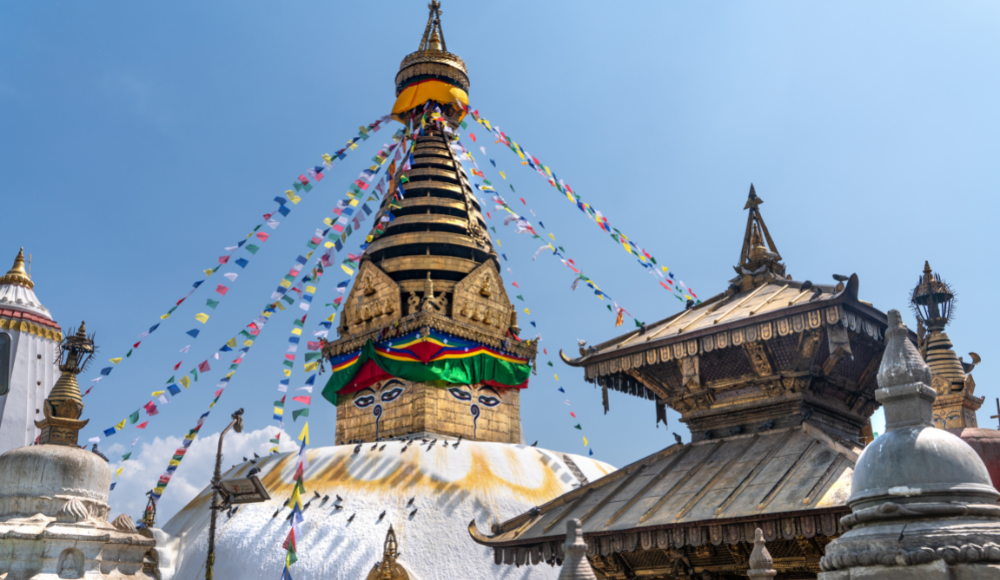
After remaining in the air for about 40 minutes you will see the large area covered by houses within a valley, this is Kathmandu. Eventually, You will land at Tribhuvan international airport which is present in the capital city of Nepal, Kathmandu. This puts the end to your 12 days trek of Everest base camp.
Additionally to this all, if you get to the Everest base camp trek during the month of May you may get to see a marathon that will be held in these regions which is called Everest marathon. This is the marathon that gets held every year on the day(29th of May) in which Edmund Hillary and Tenzing Norgay have successfully reached the summit. The race starts from Dingboche and anyone can participate in this.
Get in touch with our experts right away and finalize an experience!
About UsThe period of October to November and March to May is the idle time for the Everest base camp trek. Weather, humidity, and temperature is all good and all of the geological features present in the Everest region are clearly visible during this time.
The month of October is the starting time of festivals here in Nepal and the aurora that surrounds the environment during this period is just fantastic. The hustle and bustle of the people alongside the streets during the daytime welcomes the visitor and the fog forming in the early morning makes the environment chilly yet beautiful.
During this period of October to November, the sky is pretty clear and you can get enough views of the mesmerizing mountains. Also, the moderate temperature and the slow breezes that pass during this season make the trip more fun and enjoyable.
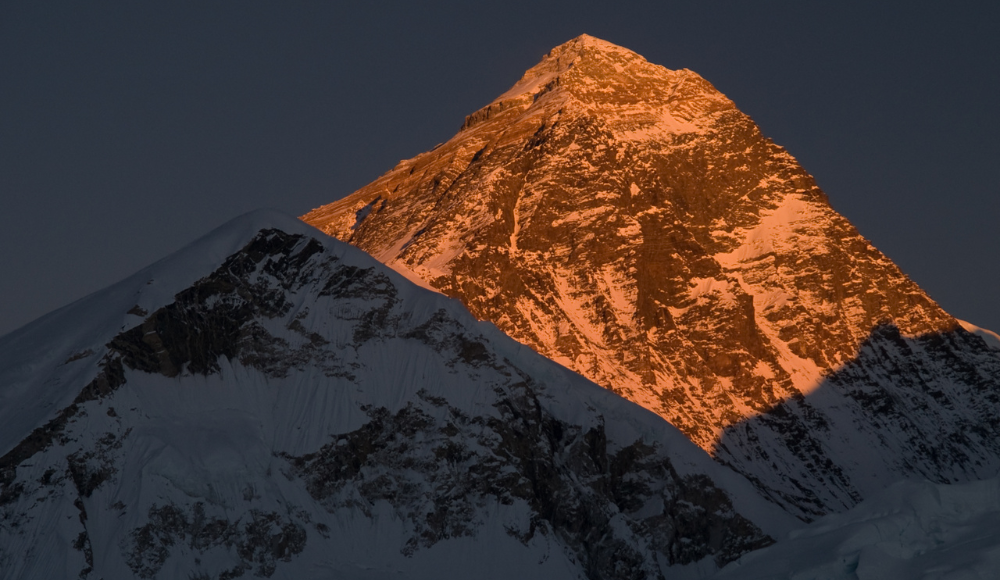
The month of March to May is another one in which you could pay a visit to basecamp. This is the period in which flowers start to bloom and these flourish the overall environment. Also, the landscapes are full of greenery during this time. This makes the surroundings look vivid and hence considered the best time to visit the Everest region.
Contrary to this, June to September is the rainy season and you are advised not to pay the visit during this period. Heavy rainfall occurs in this region hence making it impossible to trek and also December to February is also an unfavourable time as the temperature drops below 0deg celsius making the environment frosting cold.
Weather around this region is quite fluctuating. There is a vast difference in the temperature between the day and night. During the daytime in clear weather the temperature is warm but during the night it drops to freezing cold. Within a blink of an eye weather changes here. Sunny just a moment ago, changes to windy within a second.
Also, the weather is dry with extreme coldness. Strong wind blows whistling all over making it extra cold. Usually, after 12 pm wind starts to howl at a rapid speed. Talking about the temperatures, it varies according to the seasons. There are mainly four seasons in Nepal: Spring, Monsoon, Winter, and Autumn.
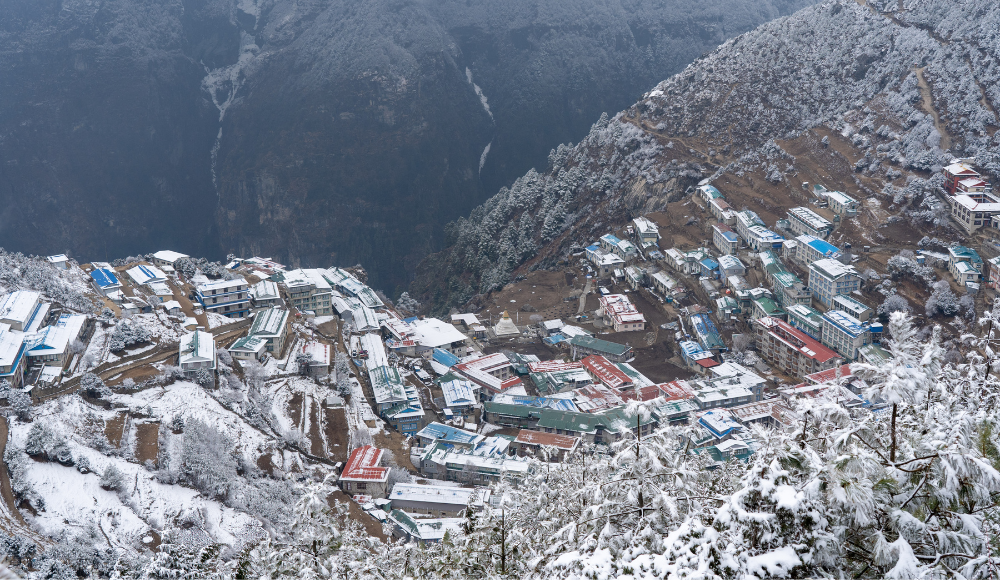
Spring season is the best time to pay a visit to the Everest region as the skies are pretty clear. Monsoon is the rainy season and you must not get there during this time because of the heavy rainfall. Autumn is a blessed time when you can get all the captivating scenarios along with the fragrance of the beautiful flowers found in that region. And lastly, in the winter, this region is usually cold even during the idle seasons but during the winter it is biting cold with heavy snowfall.
Trekking to Everest base camp is fun and adventurous but, you may experience some difficulties during your Everest base camp trek. The most common among all is acute mountain sickness( commonly known as altitude sickness ). This hits hard once you reach a higher altitude. Normally in the range where we are living, we have the availability of 92 percent of oxygen but at that altitude, we can only get about 76 percent which leads to shortness of breath.
There are various symptoms of acute mountain sickness. Some of them are difficulty in breathing, dizziness, headaches, extreme shivering of limbs, sleepwalking, loss of appetite, and many more. The one who suffers from this must get to the lower elevation as fast as possible. It can be lethal if not taken care of at the right time.
Besides this, Khumbu cough is another trek difficulty for the Everest base camp trek. The name is placed after the region Khumbu as it only occurs at the highest elevation of the mountain region. This is an extreme dry cough caused by respiratory infection and may be fatal if not treated properly at the proper time.
Also, the weather factor is to be considered. Heavy snowfall and rainfall obstruct the trek making the trail slippery. Overall, in normal weather, The trail to base camp was moderate to strenuous. A part of the trail is easy while the remaining are more difficult because of the steep uphill along with the altitude sickness kicking in sideways.
Being in the mountainous region, only the hotels, lodges and tea houses are available for the base camp trek. Because of the lack of transportation, luxurious accommodation is not possible in the higher elevation of this region. However, locals over here have tried their best to provide sufficient facilities to the visitors. Namche Bazaar, Phakding, and Lukla are some of the places where you can get adequate services.
In Namche bazaar, there are multiple 3-star, 4-star, and 5-star hotels with all the luxury. But in the higher elevation, only tea houses are available such as in Dingboche, Gorakshep and so on. There are only limited facilities available. In Namche and Phakding you can enjoy hot water showers but in the upper range such as in Gorakshep, there is no advanced facility like that.
Teahouses are the main accommodation in the Everest base camp trek as it is present all the way up to the base camp. Some of the tea houses have advanced facilities while the others only have limited ones. In lower regions such as Namche bazaar and Lukla tea houses have an attached bathroom within the room suite whereas in higher elevations it is available on a sharing basis. Not only this, various facilities differ by elevation ranging from lower to higher.
Signing in for the adventure requires good knowledge of bag packing too. Before trekking, you need to have all the necessary trekking gear and equipment. Just floundering all the unnecessary goods makes it uncomfortable for you and the trek will be difficult as you have to walk carrying these goods. So, for backpacking during your trek, you have to consider the weather, the time of your visit, and the trek difficulties. Then only you will pack your essentials. Some of the packing suggestions are mentioned below.
|
|
|
|
|
|
|
|
|
|
|
|
|
|
|
|
|
|
As mentioned above, these are the essentials during backpacking. Try your best to exclude unnecessary things and minimize weight as much as you can. Most trekkers only take warm thick clothes which are much needed and eliminate all the optional clothes so that they won't be heavy. In addition to this, pay good attention to the weather during your time of visit and pack in accordance with it.
Trekking in the mountain region comes with a risk to physical health. One most common that affects most visitors is altitude sickness. To prevent it, maintain your pace, walk slowly, drink lots of water, eat carbohydrate-rich foods, and ginger garlic soups, and keep yourself hydrated. If you feel the acute symptoms of this sickness, just get down to the lower elevation as fast as possible.
Another one is the risk caused by the slippery trails. Not all the trails to base camp are straight and easy. Sometimes you have to walk steep uphill, sometimes in between the glaciers and moraines, and sometimes through the woodlands. You may fall on the slippery path, get stuck by the bushes, and may get lost in the woods. So be sure to travel as a group with a good assistant who knows the region nicely and knows the measures to be taken in case of emergency.
Trek along with the proper trekking gear and equipment. Consider your physical health at first then only hike upwards. If you are a patient with medication for long-term diseases, don't forget to take your medicines on time. Not just accomplishing your goal by reaching the base camp is important, the most crucial is your health, so take the decision by keeping your health as the first priority.
There are no clinics in the upper altitude so be sure to carry some first aid kit along with you as it can be required anywhere anytime.
Any place we travel has its own rules and regulations to be followed. Trekking to Everest base camp also has some rules and you need to keep your mind on that. Some of the travel tips considering the rules on the Everest region are described below:
If you are travelling for the first time, be sure to take a good guide along with you.
Prepare your backpack acknowledging which one is most essential and optional.
Since you are getting into the national park region don't disturb the faunas over there.
Preserve the floras without plucking and causing any damage to them.
Drink lots of water and walk slowly.
Practice acclimatizing before getting to the higher altitude.
Don't litter the place and follow the national park rules and regulations.
Don't drink mountain water directly.
Don't violate any practice that has been in custom in that region.
The period of October to November and March to May is the favourable time for the Everest base camp trek. From October to November, the sky becomes clear making it perfect for the visit, and March to May is the season of flowers blooming and flourishing making the environment blissful.
The Everest base camp trek is a trek of 12 days. You could get the sight of majestic mountains such as Amadablam, Pumori, Everest, Lhotse, Thamserku, Cho Oyu, Lobuche, and many more. Also, you would get the chance of exploring floras and faunas available in the Everest region during your visit.
Trekking to the mountain region itself is special. Along with this, crossing the rumbling rivers, walking through the woodlands, and hiking through the glaciers make the Everest base camp trek more special followed by the views of huge mountains during your whole trek.
The Everest base camp trek is moderate to strenuous. If you get there in the right weather it is not that difficult but in bad weather, it can be arduous. Also because of the altitude sickness kicking sideways as you reach the higher elevation, it can be categorized as a challenging trek.
It is unpredictable as it varies by person. Generally, about 90 percent of trekkers face this problem during their trek to base camp. Some of them get highly influenced by the sickness, while some of them are all good to go. So, it depends on the individual.
Every year thousands of visitors trek to base camp safe and sound. So it can be concluded as safe. On the contrary, sometimes unforeseen incidents such as avalanches may occur.
You have to drink plenty of water, walk slowly, take ginger lemon tea in the early morning, include garlic-rich soups in your meal, and have dietary foods to prevent altitude sickness. Also, don't panic in case of getting this sickness and get to the lower elevation.
Follow your guide's suggestion and hike according to it. Eat lots of garlic-rich foods as it is found to mitigate altitude sickness in some range, have all the necessary trekking gear and don't hike solely.
Everest base camp is the starting point for the Everest summiteers. Also during the trek to Everest base camp, you will get jaw-dropping views of several mountain ranges and get to know about the floras, faunas, culture, tradition, and livelihood of the Everest region. This all makes the Everest base camp popular among the large group of people.
You can't see Mt. Everest from Everest base camp. This is one fascinating fact about the Everest base camp. To observe Everest you have to hike up to Kalapathar which is also a renowned hiking pace in the Everest region popular for the sunrise and sunset views.
Mountains such as Everest, Lhotse, Amadablam, Pumori, Thamserku, and Lobuche, are the prime. Along with these Floras such as Rhododendrons, Pine, and Juniper forests, Faunas such as Himalayan Yak, Musk Deer, Snow Cuckoo, Impeyan Pheasant, Monasteries such as Namche, Tengboche, and the culture and tradition of the Sherpa people are the major attractions of the Everest base camp trek.